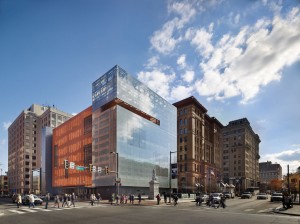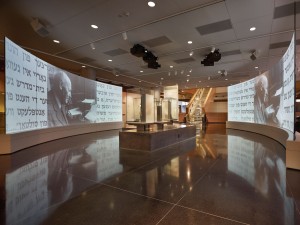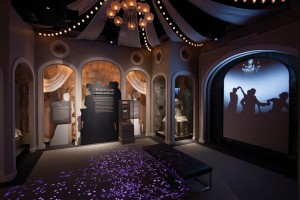Arts
Exhibit
The Arts: America Had Us at “Freedom”

From the fifth-floor terrace of the new National Museum of American Jewish History in Philadelphia you can see the whole sweep of Independence Mall.
Off to the left is the Colonial brick State House where the Declaration of Independence and the Constitution were signed. Across the neat length of the green stretches the sleek shrine of the Liberty Bell. And to your right? That’s the Constitution Center, with “We the People” writ large across its façade.
This view is about as iconically American as it gets. So it was only natural that the new museum on the block—an upscale remake of the one that since its 1976 founding had shared space with the Sefardic synagogue around the corner, and the only museum in the country totally dedicated to the history of Jews from coast to coast—should be all about freedom.
Even the look of the 100,000-square-foot building, designed by James Stewart Polshek of Ennead Architects, whose other projects include the Newseum in Washington and the William J. Clinton Library in Little Rock, Arkansas, sounds this theme. Terra cotta echoes the faded brick color scheme of this historic neighborhood. The box-like glass façade overlooking the mall projects a lightness redolent of liberty. From an upper corner, like a visual coda, Beacon, an LED sculpture by Ben Rubin, glows. Religious Liberty, a sculptural allegory commissioned by B’nai B’rith and carved from Carrara marble by Sir Moses Jacob Ezekiel, the first internationally renowned American Jewish sculptor, for the 1876 Centennial Exposition in Philadelphia presides over the plaza in front of the NMAJH (215-923-3811; www.nmajh.org).

Barry Halkin/Halkin Photography/Courtesy of the NMAJH
The heart of the building’s interior is a wide open space criss-crossed by see-through stairways and anchored, on the first floor, by the Only in America Gallery, a multimedia hall of fame honoring 18 American Jews chosen by online voters and including Barbra Streisand, Estée Lauder, Irving Berlin, Steven Spielberg, Isaac Mayer Wise and Henrietta Szold. Also on the first floor are the museum’s café and a gift shop run by American crafts expert Kristen Kreider with a separate little room where couples can seclude themselves to mull overketuba options.
But your first stop should be the fourth floor, where the core exhibition, curated by a team headed by Josh Perelman, the museum’s deputy director of exhibitions, programs and collections, with a group of distinguished historians led by Brandeis University professor Jonathan Sarna, begins with Foundations of Freedom: 1654-1880. (The displays are designed to be viewed chronologically, going from the fourth floor—the start of Jewish American history—down to the second, 1945 to today.)
Covering 226 of the 356 years of American Jewish history in less than a third of the 25,000 square feet of gallery space seems daring, to say the least. But it works. The exhibition does not seem top heavy. The Foundations gallery moves from pre-Revolutionary to Civil War times, beginning with the story of the 23 Sefardic Jews who fled from Recife, Brazil, which had been conquered by Portugal, in 1654, originally planning to go to Amsterdam but ending up in New Amsterdam—our founding fathers and mothers.
The mothers are key, here and everywhere else in the museum, according to Gwen Goodman, executive director emerita. “One of the things I always point out,” she said, “is that the women in that group of 23 were part of the reason they settled here. Because Jewish men had come before as merchants and traders, never intending to stay. But this time, with their families along, they came with the objective of staying.”

Barry Halkin/Halkin Photography/Courtesy of the NMAJH
So women—and their stories—have been central to the American Jewish experience from day one. “And from the very beginning of our planning meetings for this museum almost 10 years ago,” Goodman said, “it was very important that women should be represented throughout… whether it be in popular culture, business, Jewish renewal, war, Civil Rights…. Women played important roles.”
For example, on the fourth floor you can find the first book—one of poetry—by an American Jewish woman, Penina Moise, printed in 1833. Also here is a simple pearl necklace that must have been treasured by its owner, Anna Solomon, a Polish immigrant. She traveled by buckboard in 1876 with her husband, two toddlers and an infant to a frontier pit stop, Pueblo Viejo, Arizona, started a charcoal business, had three more children, opened a post office, then the Solomon Store, and then the Solomon Hotel, which became the social hub of Solomonville, as Pueblo Viejo soon became known.
Also, throughout the museum you will be reminded of how the Jewish experience parallels and counters, contributes to and becomes influenced by the larger American experience. And you will be taken into both everyday and existential issues that arose in the lives of individual Jews as the nation grew westward and Jewish communities developed in places like Pittsburgh, Detroit, Denver and Seattle—for one big instance: How to maintain tradition and identity in all that uncharted territory.
The audio-visual and dioramic displays on each floor do not merely elucidate; they entertain. Needless to say, this makes for an extremely child-friendly environment, something Philadelphia happens to be famous for (the Franklin Institute, Please Touch Museum). I recommend bringing your kids and grandkids when you visit; they will show you things you might otherwise miss. Also, every teacher should put this museum at the top of their field trip wish lists.
But to get back to the very special effects. Among the child-friendliest are the View-Masters in the Foundations gallery. They are located at grade schooler height and show images of stagecoaches, covered wagons, trains and other ways that the trek West was made. Meanwhile, the panels at grown-up level address events such as the publication of the first Jewish periodical, The Jew.
Then there’s the dramatic conclusion to the fourth-floor gallery—a room-spanning blowup of the famous black-and-white illustration of The Hebrew Purim Ball at the Academy of Music, which ran in Frank Leslie’s Illustrated Newspaper on April 1, 1865—about a week before the Battle of Appomattox, which ended the Civil War. In the illustration, one reveler is dressed as a New York brownstone, another as a dreidel, many others in Scarlett- and Rhett-style finery. Adding to the magic are a film showing period dances and Purim masks for the kids.
Next, descend the stairs to the third floor and the high-tech opening of the Dreams of Freedom gallery. It features an undulating movie screen constructed of separate curved sheets of plastic that look like pages adrift, tossed by the wind. Images of the massive wave of immigration that began in the 1880s are reflected on it.
According to Ariel Efron, the Israeli-born designer of this video sculpture, “Before people did this long journey, they exchanged letters and notes between continents. So we created a screen made of letters in the form of the waves of the ocean”—a symbol of the waves carrying the people who wrote the letters as they traveled to their new lives. The screen is also a vehicle on which to project the stories of five of those people: an Orthodox Jew, a secular entrepreneur, a child, a deserter from the Russian Army and a Socialist activist who was disappointed by the Bund in Europe.
For all the space devoted to the big picture in all its aspects—social, cultural, religious, economic and political—it is the personal, story after story of individuals, well known and unknown, that you will take away with you. And it is mainly through some 1,000 everyday and ceremonial artifacts from the museum’s collection of over 25,000 objects that these stories are brought to life.
To Perelman, “the pleasure of working in a museum is that you get to tell your stories in objects. Films and books re-create experience through the lens of narrators. In a museum you get to bring people face to face with the real objects of history.” And with the real men, women and children they once belonged to—or, in some cases, the way each of us imagines them.
We do not know the name of the girl who, in 1813, painstakingly stitched the exquisite sampler displayed along the serpentine wall on the fourth floor and signed it S.G.M. But since two lines of alef-bet follow the alphabet stitched onto the linen, we can assume she was Jewish. And she must have had quite an imagination because her motifs are not limited to traditional birds, trees and flowers; she also stitched a tiny lion of Judah, a table set for Shabbat, a ladder (Jacob’s?), Rachel’s well (complete with pitcher) and a needlepoint artist (herself?) at work.
On the third floor, an early-20th-century shohet’s knife is accompanied by a cotton-and-cardboard sheath with an American flag design. The artisan may have been the shohet himself, crafting a secular cover expressing his American identity for the tool of his traditional Jewish trade.
Other objects will seem more familiar, even familial, especially in the second-floor gallery, which is called Choices and Challenges of Freedom: 1945-Today and includes a shout out to that great American Jewish institution, the summer camp, with a reproduction of a camp cabin, complete with bunk beds, Adirondack chairs and a packed trunk. The floor also has side trips into feminism, civil rights and the koshering of mass-market consumer products. That may not be your mother’s Hadassah canasta deck in the display about midcentury leisure activities but it will make you nostalgic for the ’60s, anyway, with its nurse and baby image on every card.
A pair of floral-patterned children’s pajamas in a display case tell a heart-rending World War II rescue story. They belonged to 8-year-old Helga Weiss, whose parents, Emil and Rosa, had a seamstress make this garment from one of Rosa’s dresses before sending their daughter away from imperiled Vienna to live with a foster family in America. The Steiff teddy bear also showcased was Helga’s companion on the journey.
And the steamer trunk with fancy silver hinges, hotel and ocean liner decals and the initials J.J.? It was packed with the belongings of Josef Joseph and his family; they had tried to escape the Nazi plague by sailing on the S.S. St. Louis to Cuba where, like many others onboard, they planned to wait until their visas to the United States became valid. When it became apparent that this would never happen, and that the St. Louis had to return to Europe, Joseph, who eventually made it to the United States, joined the committee formed by Captain Gustav Schroeder to console the despairing passengers.
Although this is a very big exhibition,” Perelman said, “we recognized early that we can’t tell every story. When you are doing something this large, it takes a village—curatorial staff, historians, designers, all working together. You have to make choices.”
So inevitably, visitors will remark not only on what they see, but on what they don’t see. Where, for instance, is a display on Chaim Potok? He lived in Philadelphia, after all. And where is Bernard Malamud? Ralph Lauren? And shouldn’t there be more on Cynthia Ozick and Woody Allen?
“You’ll note,” Perelman said, “that it’s the ‘core,’ not the ‘permanent,’ exhibition. The physical structure and main narrative will remain the same but objects will rotate. There will always be subtle changes. And then we have the special exhibit space on the fifth floor, which gives us a way to address subjects that aren’t in the core exhibit because of tightness of space. But there won’t be special exhibits for at least a year. We want to give the core exhibit a lot of time and respect.”
As it richly deserves. Because sooner or later, probably around the time you find yourself in the amazing midcentury kitchen in the heart of the second floor’s reconstruction of the postwar move to the suburbs, perhaps as you peruse the cookbook titles—Molly Goldberg’s, the Euclid Avenue Temple Sisterhood’s, Hebrew National Kosher Delicatessen Presents 31 Ways to Make Hot Meals Out of Hot Dogs! —you might find yourself thinking, “Imagine what Anna Solomon would think if she were able to to see this museum!” Or “Imagine what Henrietta Szold would think!” Or Helga Weiss. Or, in my case, “Imagine what my great-grandparents who came from Ukraine to McKean Street in South Philadelphia in 1899 would think!”
The fact is, none of them could have imagined that someday there would be a Jewish museum right on Independence Mall. And the mere arrival in this place, at this time, of this museum about the American Jewish take on freedom tells us before we even go inside what freedom is all about.
Elin Schoen Brockman is at work on her memoir; her Enlightened Shopper blog, www.enlightenedshopperblog.com, is updated several times a week.










 Facebook
Facebook Instagram
Instagram Twitter
Twitter
Leave a Reply